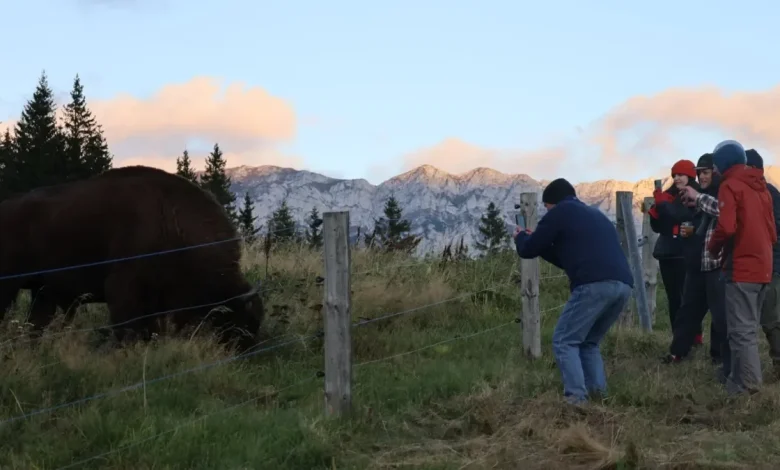I escaped Dracula tourist tat to hike among Transylvania’s bison and bears

The Fagaras Mountains include some of the most extensive old-growth forest in Europe, where there are plans to create a new national park
Anna has me in raptures as she bathes in the late afternoon sun. Shaking her head from side to side, she flicks a halo of water droplets skyward from her glossy hair in movie-starlet-like splendour. All that’s missing is the slow mo.
Spotting Anna, one of the estimated 6,000 brown bears in central Romania’s Fagaras Mountains, is an auspicious start to a week in this region, particularly since she’s accompanied by four others.
Bulky mature males and a lanky juvenile, with the awkward movements of someone only just getting to grips with their limbs, are all eager to share the bounty of sweet corn kernels scattered by “bear whisperer” Peter Levente, one of the permanent staff here on the Zabola Estate.
“You can get them here almost every day,” says Bence Máté, a Hungarian award-winning wildlife photographer, who recently built the hide I’m sitting in. Romania has all of Europe’s large predators in relative abundance, including its biggest single population of brown bears.
About 90 minutes’ drive from Bran Castle, fictional home of Dracula and the real source of tacky vampire-themed fridge magnets, Zabola offers a different take on Transylvania, an area still remarkably free of the usual trappings of international tourism.
The Fagaras mountains in the mist (Photo: Anton Petrus/Getty)
Instead of dodging blood-sucking creatures of the night, here it’s all about catching sight of tufty-eared red squirrels darting between trees before breakfast, admiring black storks flying bat-like above the ornamental lake, and keeping a sharp lookout for the telltale signs of lynx, wolves, bison and beavers. This leads to the close-up examination of rather a lot of scat (poo to you and me).
Leaning into the fact he’s a Transylvanian count, Zabola’s co-owner Gregor Roy Chowdhury – his surname coming from his Bangladeshi father and his dapper demeanour from time studying at the London School of Economics before banking in the City “like everybody else on the course” – is quick to highlight the region’s understated reputation, Dracula aside.
“Was your flight full of Western tourists?” he asks. “No,” he answers for me. “Brasov airport was built for Romanians returning home. Before the change [the end of communism in 1990] the population was 22 million. Now it’s more like 19 million. The difference is those working abroad and sending remittances home.”
Bucking the trend is Austrian-born conservationist Barbara Promberger, who arrived in the Fagaras Mountains some 30 years ago and is the founder of Travel Carpathia and Foundation Conservation Carpathia, alongside her German-born husband Christoph.
There are thousands of brown bears in the region (Photo: Kate Heightman)
The foundation cares for 28,000 hectares of forest, with the goal of protecting roughly nine times more with the creation of a new national park aiming to rival the US’s Yellowstone in status if not scope.
“We were flying for a whole hour and all you could see was forest, forest, forest,” says Barbara, of their decision to purchase the land and conserve the most extensive old-growth forest in Europe in the process.
But it’s in pulling on a pair of hiking boots that I really get a sense of its scale and importance. I’m led by local guide Oana Harabagiu, who has a can of bear spray hanging from her belt, though bison are the bigger threat. Following the reintroduction of a small number of bison in 2019, there are now more than 100. What do I do if one gets too close for comfort? “Run,” Oana recommends.
Hikers stay in a tented camp in the Fagaras Mountains (Photo: Kate Heightman)
We traverse an unsurfaced forest road, sticking close for protection, before slipping under the shade of spruce and beech trees. The path rises over a steep hill, soft underfoot with fallen pine needles.
We pass an array of mushrooms so impressive even the priciest of farmers’ markets wouldn’t be able to compete, from the red toadstools of children’s books to the pungent brain-like forms of cauliflower mushrooms growing low on tree trunks. The scent is sadly not lost by the occasional gusts of wind passing through the upper branches with the sound of a roaring torrent of water.
Mushrooms abound in the forests (Photo: Kate Heightman)
The bellowing of red deer stags in rut also echoes around the V-shaped valleys of the Dâmbovita River, coming in and out of earshot like a shortwave radio signal throughout the afternoon and in to dusk, when Oana and I stand on a ridge that’s also a wildlife corridor.
“Let’s move on,” she says as the light fades. “There’s something in the bushes and I don’t know what it is.” It’s certainly not bison. When a herd of a dozen does make an appearance, we’re safely behind our tented camp’s electric fence. But, having got to know the Fagaras, I’m ready to believe it could be almost anything – except perhaps a vampire.
Getting there
Brasov is served from Luton by Wizz Air.
Getting around
The writer was a guest of Travel Carpathia, Zabola Estate and the European Nature Trust, whose seven-day Coexistence Adventure costs from £3,500pp with departures in May and September 2026.
More information
romaniatourism.com





